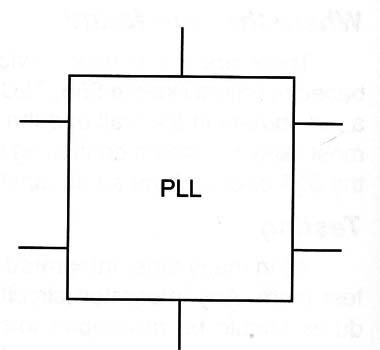This article is the continuation of RT203. See more in that article about integrated circuits.
Symbol
Figure 1 shows the symbol of a PLL.

The body is not different from any other linear function described here. The only way to know if the IC is a PLL is by its part number displayed as a number on the component’s body.
Specifications
As any other IC, the PLLs are indicated by a part number. Using the part number, it is important to know some electric specifications when using a PLL or when trying to find a replacement type. The main specifications are:
A. Power supply voltage range-the voltage range in which the device functions.
B. Frequency range-a very important specification as it indicates the maximum frequency of a signal that can be recognized by a PLL or generated by it when operating as oscillator. Common general purpose PLLs, such as the 556, can operate at frequencies up to 500 kHz.
C. Sensitivity-the minimum amplitude of a signal that can be recognized by a PLL.
D. Output current-this specification indicates the amount of current the device can source or drain when driving a load.
Where they are found
In many modern applications, the PLLs are included in more complex lCs.
But, some exist that are for a simple application made by small manufacturers, or even made by amateurs that use the PLL as a single chip. In these case some common types, like the 4046, LM567, and others, can be found.
The next applications can give to the reader of how useful are the PLLs.
A. Remote control-used to recognize a tone sent by the transmitter (using a radio signal or IR) and act on a device (the motor of a garage door, or a function of an electric or electronic appliance)
B. Intercoms-Some types use the AC power line to send the sounds. The sound picked up by a microphone is used to modulate a circuit producing a frequency-modulated signal that is applied to the AC power line. A PLL in the receiver detects this signal and applies it to an amplifier.
C. Alarms-a tone is produced by a circuit and applied to a PLL via sensors. If any sensor is activated the PLL detects the absence of the tone and triggers the alarm.
Testing
The same procedure as recommended for others ICS is valid here: measure the voltage at the pins and compare it with the expected values.
Other Linear Functions
Many other functions can be found in linear le. Besides those described before, the reader can find le containing video amplifiers, comparators, voltage references, radio receivers, etc. There isn’t a specific symbol for these functions and their aspects are the same found in other lCs.




